Clan Focus – The Dragon
Togashi Kazue by Le Vuong
During their Gempukku Samurai of the Dragon clan consider the story of their founder Togashi and the wise Shinsei. They compose a Haiku to explain their own understanding of the story.
The Kami Togashi sat beneath the plum tree in quiet contemplation of the words of Shinsei. He had vowed to neither eat nor drink until the wisdom that he sought revealed itself to him. Around Togashi his followers Mirumoto and Agasha waited, loyal to their Lord. After many days Mirumoto and Agasha became concerned as their Lord had not touched water or rice in all that time and they pleaded with him to eat. On the 10th day, Togashi could barely speak, he was dying. When Shinsei came upon this, he asked Togashi what he was doing. Togashi replied: “I will not move until I understand”. Shinsei smiled and nodded and sitting next to Togashi said: “Neither will I”. It was at this moment that Togashi understood.
What Togashi understood was never explained, but each Samurai of the Dragon clan finds their own meaning in the story starting on their own path to enlightenment.
For this review of the Dragon cards, I’ve grouped them into themes, cards that work well together or do similar things. I’ll start with the Clan Stronghold as that is pretty defining for the clan as a whole and I’ll finish on the Clan Champion and some of the fun things Togashi Yokuni can do.
Stronghold
 The Dragon Clan Stronghold
The Dragon Clan Stronghold
Looking at just the numbers, the Dragon clan’s Mountain’s Anvil Castle is the same as the Crane stronghold and just 1 honour lower than the Lion stronghold. Compared to the Lion and Crane strongholds the Dragon Clan’s ability is a little weaker but a lot more flexible. It requires you have a character with at least 1 attachment and preferably 2. Even with 2 attachments it only gives +2 skill to your overall total at the end of the conflict. On the other hand, it can be used on attack or defence and in either Military or Political conflicts. As the ability gives the bonus to both military and political skill, it will help duellists boost their duelling skill regardless of the type of the current conflict. So, from just the stronghold alone we can expect Dragon to play attachment cards and be balanced between military and political conflicts.
Theme 1: Attachments
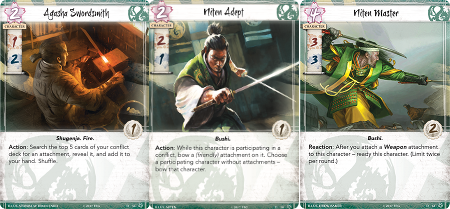 Attachments — Dynasty Cards
Attachments — Dynasty Cards
The Agasha Swordsmith has what we’ve learned is a standard stat line, 2 Fate cost for 1 Military, 2 Political, and 1 Glory. Where this character shines is the ability. The ‘impulse’ style effect lets you look at the top 5 cards of your conflict deck, reveal an attachment card and add it to your hand. Free once per turn card draw, fantastic. This does let you fetch weapons such as Fine Katana but also gets other types of attachments such as Cloud the Mind. It is also quite convenient that the Agasha Swordsmith has the required Shugenja trait to play Cloud the Mind which is a versatile card.
The Niten Adept at 2 Military, 1 Political, and 1 Glory for 2 again has a pretty typical if unexciting stat line. Unlike other examples with these stats, fresh from the province the Adept has no ability. Once you manage to get an attachment on the Adept, things significantly improve. In a conflict, by bowing the attachment, you can bow an opposing character without attachments. Clearly, this works well with the Agasha Swordsmith who fetches those attachments. It is notable that it does not necessarily have to be a weapon and any attachment can power this ability. The ability works best works best with attachments that do not require bowing such as Fine Katana or Ornate Fan rather than Jade Tetsubo. As the target must have no attachments, this works well with attachment destruction cards. Despite the slightly higher Military skill, the Niten Adept’s ability is as good in a Political conflict as a Military conflict, and this is a flexible character that can be tailored as needed with the right kind of attachment.
Niten Master takes a different approach, where the Niten Adept requires an attachment to use their ability, the very act of attaching a weapon powers the Master’s ability. At 4 fate for 3 military, 3 political, and 2 glory the Niten Master essentially has the stat line of the Adept and the Swordsmith combined. After you attach a weapon to the Master, he unbows and this can be used up to twice a turn. So if you have the Niten Master in play and two Fine Katana in hand you can attack with the Master at 3/3, attach a Fine Katana after the conflict to unbow him, defend in another conflict as a 5/3, and then attach the second Katana after that conflict and attack as a 7/3. As the weapons we have seen so far, Fine Katana, Ancestral Daisho, Jade Tetsubo, and Honored Blade all contribute to military skill often you will want to assign the Master to a political conflict first. As the Master has 2 glory, he is an excellent target for Court Games in that first conflict. This is a powerful ability, but as all the weapons we have seen so far are restricted, once you have used the ability twice you cannot use it again without destroying a weapon. Due to the way the restricted keyword works, it is possible to play a third restricted card to trigger the ability and then discard down to two weapons.
 Attachments — Conflict Cards
Attachments — Conflict Cards
To play attachments we need some attachments to play. The basic attachments we have seen already are the Fine Katana, 0 cost for +2 Military skill Weapon and the Ornate Fan, 0 cost for +2 Political skill. Add to these the Dragon only versions to power the deck.
The Ancestral Daisho mirrors Lion’s Honored Blade and is also comparable to Fine Katana. Fine Katana is a 2 Military skill attachment with the restricted keyword meaning. For the extra 1 Fate with Ancestral Daisho, you also get the Ancestral keyword which returns the card to hand when it leaves play. Is that worth an extra Fate? Paying 1 fate to draw a card might be worth it. This does allow you to drop the Ancestral Blade onto a character that is leaving at the end of this turn and essentially gain the card again to be used another time. The Daisho will not return if it is destroyed in some way.
The Kitsuki’s Method is the political equivalent of the Ancestral Daisho, identical in all ways except it lacks the weapon keyword and boosts political skill rather than military skill. That political boosts are a little trickier to get may increase the value of the this, but the lack of Weapon trait doesn’t trigger the Niten Master’s ability. The majority of the time it is unlikely the ancestral keyword is going to make a lot of difference. Often you will be trying to drop attachments onto characters that are going to stick around as long as possible. Another approach with the ancestral cards is to play them on cards that are going to be leaving play soon are vulnerable to cards such as Assassination. Playing a Kitsuki’s Method on a Niten Adept makes him a very tempting target for removal, but when he leaves the Method returns back to hand.
Way of the Dragon is a 2 cost attachment for +1 Military and +1 Political skill, but it could just as easily be blank as the card text is the real focus. This allows you to use triggered abilities on the attached character an extra time per turn. Normally an ability can only be used once per turn (unless it specifically says otherwise like the Niten Master). If you attach this to the Agasha Swordsmith, you can grab two attachments each turn. If you attach this to the Niten Adept you can bow two of his attached cards, the Way of the Dragon included, to bow an opposing character. Although it costs a painful 2 Fate this is a pretty powerful card and every time you see a Dragon character with an ability you need to ask yourself, what would I do with this if I could use it an additional time each turn?
Daimyō’s Favor is a 0 cost attachment, which already makes it of interest for the Dragon. It gives no skill boosts but can bow to reduce the cost of the next attachment to be played by 1. For the attachment heavy Dragon decks, this effectively is an extra fate every turn. It is perfect for the ancestral cards which both cost 1 fate and are reduced to free.
Rounding out the attachment theme the Dragon get Let Go, a 0 cost action that discards target attachment. This is a multi-use card and can provide a good amount of Fate advantage. The first use is to destroy your opponents weapons and attachments removing their toys and making them vulnerable to the Niten Adept. The second use is to remove negative attachments your opponent may have placed on your characters such as the Phoenix Pacifism or the neutral Cloud the Mind cards. Depending on the target, the 0 cost Let Go can provide a hefty Fate advantage, especially if it is destroying a 2 cost attachment such as Height of Fashion.
Theme 2: Fate and Rings
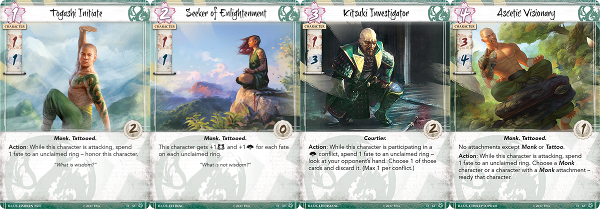 Rings and Fate
Rings and Fate
A number of characters share a theme around Fate on Rings. The Togashi Initiate, Kitsuki Investigator, and Ascetic Visionary all have abilities which have a cost of paying a Fate from your pool onto an unclaimed Ring. This gives your opponent the opportunity to grab that Fate but if correctly played gives you the opportunity to reclaim it yourself.
The Togashi Initiate is well rounded at 1 Military, 1 Political, and 2 Glory for 1 Fate. The ability to pay a Fate to honor the Initiate turns it into a 3 Military and 3 Political. This provides both a great stat line for winning Conflicts and a point of honor once the Initiate leaves play. This is similar to the Crane’s Brash Samurai although the Brash Samurai ends up 1 higher in Military. The Initiate only requires a 1 Fate initial investment and has an arguably easier to trigger ability just needing to attack rather than being solo. As the ability can only be used on the attack, your opponent will normally have the next opportunity to claim a ring. The exception to this if you declare the last conflict of the turn and have the initiative next turn, you will be able to claim that Fate back in your first conflict.
The Seeker of Enlightenment is a tricky one to judge as the cards stats fluctuate within a turn. The cost of 2 Fate for 1 Military, 1 Political, and 0 Glory isn’t very exciting. For each Fate on each unclaimed ring, the Seeker gets +1/+1. The main way for Rings to get Fate on them is at the end of Turn when you check to see which Rings were not claimed. On turn 1 this will be a +0/+0, but from turn 2 onwards you can expect there to be at least 1 and maybe 2 Fate sitting on Rings at the start of the turn. This does, however, fluctuate as conflicts are declared and Fate is claimed from Rings. The other way of getting Fate on Rings is using abilities such as on the Togashi Initiate. This will require some mastery on the part of the Dragon player to balance things but does have the potential to pull out unexpected skill.
The Kitsuki Investigator is the first and only Courtier we have seen in the Dragon. Unfortunately, this indicates that Courtier cards are not going to be viable for the Dragon. At 3 cost for 1 Military skill, 3 Political skill, and 2 Glory the Investigator doesn’t have very exciting abilities. The ability has the same wording as the Initiate to place Fate on an unclaimed Ring importantly can be used on the defence as well as the attack. The actions effect allows you to look at your opponent’s hand and discard a card. This has the double effect of letting you know exactly what options your opponent has as well as letting you remove the best of those options. The ability, understandably, is limited to a Max of 1 per conflict, this limit still applies even if you have multiple Investigators or Way of the Dragon. You can however do this in both of the political conflicts if you can manage to get an Investigator in each. This is an amazing ability that is very unique to the Dragon.
The last of the fate to ring characters is the Ascetic Visionary a 4 cost 3 Military, 4 Political skill, Character with 1 Glory. He has a limitation that means he can only have Tattoo or Monk attachments which one one hand prevents the Dragon player from dropping an Ancestral Daisho on him but on the other hand, stops your opponent from dropping Pacifism or Cloud the Mind. Like the Initiate, the ability can only be used on the attack and spends a Fate to an unclaimed ring to Straighten a Monk Character or a Character with a Monk attachment (more on this later). The limitation of who he can target is limiting, but that he can only do it while attacking is the real difficulty. It does counter bow effects in a battle which is good, but it means you won’t be able to unbow a character who already attack to allow them to assign to the next attack. This combined with the no attachments condition and the high cost pushes the Visionary out of many decklists.
Theme 3: Influencing Fate
 Gaining Fate
Gaining Fate
Doomed Shugenja has the political power of Doji Whisperer and the military power of Matsu Berserker all rolled into one. This offers a lot of flexibility but comes at a cost, the Doomed Shugenja cannot have any Fate added to her when played from a province. If this character is to start around more than 1 turn, then we need some other way of adding Fate to her. Also, only one Doomed Shugenja can be played each turn due to the limited keyword (currently the Doomed Shugenja is the only card with that keyword). When we first saw the previews, this seemed like a pretty big drawback, but the more we play, the more we realise that many characters will just come out for a single turn and that is okay. For 1 cost the Doomed Shugenja provides a pretty big impact and is a worthwhile investment.
The Enlightened Warrior is a 3 cost Bushi with 2 military, 2 political, and 1 glory. Not a very exciting stat line. The ability is a reaction to whenever your opponent claims fate off a ring and adds 1 fate to the Enlightened Warrior. This puts your opponent in a bit of a bind, either they give the Enlightened Warrior a fate or they leave the fate on the rings for the Dragon player to claim later. This makes the Enlightened Warrior a stable, if unexciting, character for attachments. Although just a 2/2, that Warrior is likely to be still there on the last turn of the game.
Adding to your opponents worries, if they choose the ring of fire you can then play the Mantra of Fire which is a 0 cost event which adds a fate to one of your Monk characters or a character which has a Monk attachment, it also replaces itself letting you draw another card. This is free in so many ways. As the ring of fire is such a good effect and there is a good chance you will have added fate onto it to tempt your opponent the only real requirement is having a Monk in play. This timing dilemma is the reason this isn’t getting slots in decks currently. With decks made from 3 cores it is certainly possible to have a viable target, you have to wait for that to align with your opponent declaring ring of fire. During that waiting period, the card is essentially dead.
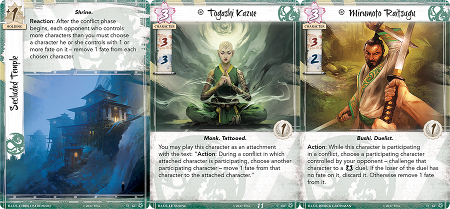 Removing Fate
Removing Fate
We’ve seen adding Fate to Rings, we’ve seen gaining Fate, the next step is removing Fate from your opponent. Secluded Temple is the Dragon clan holding, so it comes into play at no cost and adds +1 to the strength of your Province. At the start of the conflict phase, you can trigger this ability if your opponent has more characters than you to get them to remove a Fate from 1 of their characters. As we only get 7 Fate each turn, this is a pretty big impact, especially if you can trigger this a few turns. This encourages the Dragon to keep their character count just a little bit lower than their opponents.
Togashi Kazue is the first of the two conflict characters the Dragon have. In a unique twist, these characters can be played as either a conflict character as normal or as an attachment. Kazue, when played as a character, is a respectable 3 Military, 3 Political, and 1 Glory for 3 Fate. As a surprise addition to a conflict an extra 3 skill for 3 fate is helpful but isn’t very exciting. Unlike more efficient cards such as Height of Fashion, Kazue is useful in either type of conflict. If Kazue is played as an attachment the fun really begins, the character Kazue is attached to can take a fate from an opposing character and add it to themselves. On the one hand, this isn’t going to win the current conflict, but it could have a big impact on the game. For 3 fate cost, you hopefully will remove one fate from an opponent’s character (although you can target a friendly character) and will add 1 fate to your own. In that regard it is slightly fate inefficient; however, you can do it again the next turn. It is also important to realise that not every fate is equal, a point of fate on a Togashi Initiate is not the same as a point of fate on Togashi Yokuni. This is a costly card at 3 but could win games. Unfortunately this high cost makes it an especially painful target for attachment hate cards such as Let Go and Calling in Favors.
Rounding out the fate removal, we have Mirumoto Raitsugu who has the first legitimate ‘kill’ duel. Raitsugu has 3 Military, 2 Political, and 1 Glory for 3 Fate. His ability starts a military duel against an opposing character in a conflict, if the loser of the duel has any fate on it then 1 fate is removed, if the loser has no fate, then the character is discarded from play. A powerful ability indeed, one which is enhanced by the Dragon clans attachment focus and the Stronghold’s ability which could easily push Raitsugu to levels where the duel is decidedly one-sided. With a Way of the Dragon Raitsugu can take two actions to kill a character with 1 fate on it. With the Crab’s Jade Tetsubo Raitsugu can return the fate on any character and then kill them.
Theme 4: The Solitary Samurai
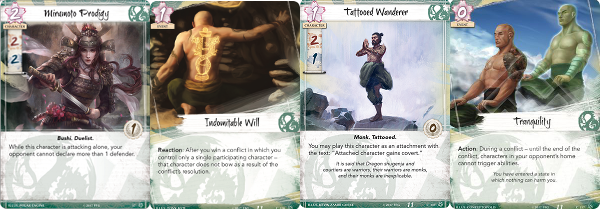
The Way of Walking Alone
One of the stated themes for the Dragon has been having a geared up character with lots of attachments. The Mirumoto Prodigy is a perfect character for this. When the Prodigy attacks alone your opponent can only choose one defender. The Prodigy provides an excellent target for weapons provided by the Agasha Swordsmith to build that super unit. This does make for an ‘all your eggs in one basket’ scenario, so she does need support to make sure the Prodigy isn’t bowed or sent home with a single action. The Prodigy is also vulnerable to Assassination making her an even greater risk. Another option is to assign the Mirumoto Prodigy alone and then support her using cards like Favored Mount and Favorable Ground to move units to support in during the conflict.
Indomitable Will is another example of the Dragon’s solo Character focus. If you win a conflict where you only control a single Character, like the Prodigy, then you can play this to prevent your character from bowing at the end of the conflict. This keeps your Character ready for the next conflict and doubles their effectiveness for that turn. Although the 1 Fate cost can be hard to swallow when you consider you are getting an extra character for the turn, it will often be worth it. Unlike Lion’s Sashimono you do not need to have this in play ahead of time. You will need to win a conflict, but you’re hopefully planning on doing that anyway. Although your opponent may expect Indomitable Will they will need to stop every attack where you have a single character to prevent you from playing it.
The Tattooed Wanderer is another example of a conflict character like Kazue that can be played as an attachment. For the cheap cost of 1 Fate, the Wanderer is a 2 Military, 1 Political, and 0 Glory. Getting 2 skill for 1 Fate is decent especially as a surprise conflict character. As an attachment, the Tattooed Wanderer gives a character the covert keyword. Covert is: when assigned to an attack a character with Covert can select an enemy character without the covert keyword to prevent them from assigning to that battle. Like Mirumoto Prodigy, this helps you select the fight you want limiting your opponents options. It also provides a good defense against your opponents Covert character.
Tranquility is a different look at the same approach. Rather than focusing on the single Dragon character, Tranquility prevents characters outside of the conflict from using their abilities. Currently, this is an overly situational card with minimal impact on the current card pool.
We’ve looked at some solo focused cards here, but this is a theme that actually crosses over with a few of the others. Attachments make your big solo, so everything attachment related works into this. Getting more Fate on your big character keeps them around, so Mantra of Fire and Togashi Kazue help with that. When you have that Voltron, you want to be able to get more out of it. So cards that can ready your character like Niten Master and Ascetic Visionary help maximise your investment.
Theme 5: Defending the Mountains
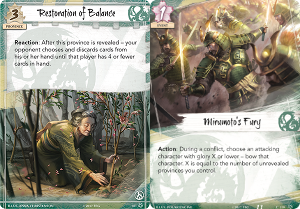
Defending the Mountains
The Dragon’s unique province is the Restoration of Balance which brings your opponent’s hand down to 4 cards. As a reaction to revealing, this is a one-shot only province. Timing is everything for this. The best scenario is one where both players have drawn 5 on turn 1 and this is the first province your opponent hits. Unfortunately, very often your opponent will hit this province when they have between 3 and 5 cards having little impact. The 3 province strength then makes it very vulnerable. In metas where drawing few cards is the norm, this province won’t have much impact. Restoration of Balance is a fire province meaning it competes with Meditations on the Tao and Night Raid both of which are 4 province strength. Night Raid has a similar effect but different conditions that mean while the card discard is unlikely to be so impactful it will always be at least 1 card. Meditations on the Tao as another option feeds well into the Dragon’s fate control theme with Togashi Kazue, Secluded Temple, and Mirumoto Raitsugu and might be a better choice overall.
Mirumoto’s Fury follows a typical format we have seen with the Crane’s Admit Defeat and Lion’s Strength in Numbers. The cost is 1, there is a condition to the use (defending), and a condition on the target (glory equal to or less than your provinces revealed). The effect is to bow the target character which will prevent them from contributing their skill to the conflict but will not stop them from using their ability (unless it has a bow cost). As we have 5 Provinces, on the first attack when the first is revealed you will be able to bow characters with glory 4 or less (everyone without the meddling of the Phoenix stronghold). As more provinces are revealed, this will reduce until at the very worst only 0 Glory can be targeted, although this would require all 5 provinces being revealed which won’t happen in many games after the three provinces are broken the last conflict will be at the stronghold province. Given the lower number of characters going into conflicts, a card like this can do a lot of work. That it doesn’t require presence to save your province allows the Dragon to focus on attacking while relying on this card to hinder their opponents attacks.
The Clan Champion
 Togashi Yokuni
Togashi Yokuni
Finally, we get to Togashi Yokuni. This Character is a real beast. The character is similar in many respects to the Crane and Lion clan champions in that it is 5 cost with 3 Glory. The skills of 5 Military and 5 Political for Yokuni compare to the 3/6 of Hotaru and 6/3 of Toturi. Although Yokuni won’t be able to beat either of the champions at their own game, he is far more flexible (something the Dragon have shown again and again). The ability is astounding, once per round Yokuni can copy a triggered ability. To really grasp this we have to go all the way back through all the Dragon cards to see what we can combo with just within the Dragon deck.
- Agasha Swordsmith: Impulse for an Attachment
- Ascetic Visionary: Spend a Fate to unbow a Monk
- Enlightened Warrior: Gain a Fate when your opponent gets Fate off a Ring
- Kitsuki Investigator: Spend a Fate to look at opponents hand and discard a card.
- Mirumoto Raitsugu: Duel to remove a Fate or discard a character
- Niten Adept: Bow attachment to bow an opposing character without attachments
- Niten Master: Unbow after getting a weapon
- Togashi Initiate: Spend a Fate to become honored
Then consider all the fun you can have with the best ability on your opponent’s characters! Then add a Way of the Dragon and be twice as good as your opponent’s character!
 Togashi Mitsu
Togashi Mitsu
Allying with the Dragon
All of the Dragon cards are 2 influence, so if we are splashing Dragon you get exactly 5 cards or 6 if you have a keeper role. The Ancestral Daisho and Kitsuki Method are both solid cards that will help round the skill in a deck but aren’t by themselves worth splashing for. Indomitable Will provides a way to double the effectiveness of any character that wins a conflict by itself, something a lot more common that we originally thought. The Mantra of Fire is limited to Monks which so far no other clan has, this might change with Phoenix but right now is not an option. The Tattooed Wanderer and Togashi Kazue both provide good flexibility between character and ability. For most clans, I would imagine the Wanderer’s cost of 1 would be far more playable than Kazue’s 3 cost. Mirumoto’s Fury is by far the most attractive card and would be useful for pretty much any deck. Stalling just one attack can win the game. Let Go, as 0 cost action, is great for removing problem attachments and often will negate a 1 or 2 Fate cost investment of your opponent. Unlike with the previous two Clan Focus articles, I feel the Dragon’s contribution is pretty similar across all clans. Mirumoto’s Fury and Let Go are both the cards of choice for me, some combination of 3 and 2. Let Go will be a bit meta-dependent and if it is the case that only the Dragon are playing attachments might be better replaced with the Tattooed Wanderer or Indomitable Will.

Crab has a number of attachments that are of interest to the Dragon. Reprieve at 1 influence helps them keep their big character around an extra turn. Jade Tetsubo at 2 influence is another weapon for the Niten Master and works amazingly well with Mirumoto Raitsugu. The Mountain Does Not Fall at 3 influence helps get more use out of a character in a similar way to Indomitable Will.
Crane provide a solution to the big fear for Dragon, character kill. Above Question is a 2 influence attachment that prevents your opponent from targeting the character with events. This keeps Niten Adept safe from Assassination and gives him an attachment to bow. It keeps your big unit safe from Way of the Crab, Noble Sacrifice, and I can Swim. The Crane also have Admit Defeat at 2 influence which can bow a solo defending unit, something that combos well with Mirumoto Prodigy. Finally, they have Duelist Training at 1 influence which gives a character a duel that bows. As the Dragon are well able to make super units they will be able to bully duel and Way of the Dragon allows them to issue the duel a second time.
Lion provide an extra weapon, Honored Blade at 1 influence, which helps with duels and the Niten Master. Sashimono at 2 influence, helps get more use out of a single powerful character, as long as that character is a Bushi, which many of the Dragon are. The Lion also have Strength in Numbers a 1 influence send home action and Ready for Battle a 1 influence reaction which straightens your character after an enemy card or ring bows it. Lion are where clans go when they need more battle actions.
Phoenix have limited options for the Dragon play style. Pacifism at 2 influence is a good attachment to stop an opposing character from assigning to a military conflict. Display of Power is a popular splash at 3 influence allowing you to not defend and instead claim the very ring your opponent was attempting to grab.
Scorpion again don’t offer many options. Calling in Favors at 2 influence is a way to steal your opponents attachments, leaving them vulnerable to the Niten Adept and gaining them yourself. The Adept of Shadows at 3 influence is a conflict character who can bounce back to the hand in a way similar to an ancestral item. The Court Mask is similar, an attachment that can return back to hand dishonoring the character it is attached to. The Unassuming Yōjimbō at 2 influence is an extra covert character to go along with the Tattooed Wanderer, helping deny more defenders. Ultimately Scorpion are played for Forged Edicts and without the Courtiers to support it, they aren’t really an option with Dragon.
Unicorn have a lot of cards that are cavalry only, which limits the options. They do have two attachments of note, Spyglass and Favored Mount. Spyglass is a massive boost for card draw and will quickly return on its investment. Niten Masters ability and Indomitable Will help trigger this the second time in the turn. Favored Mount is a way to counter send home effects and also allows units to be let behind and moved in only when needed. This works well with the Mirumoto Prodigy who can assign as a simple 2/2 forcing your opponent to only declare one defender, then during the battle, you can move your larger units in with the Favored Mount. Favored Mount and Spyglass also combine to trigger an extra card. Although of less use for the Dragon than other clans, Captive Audience could be a good option against clans that are politically focused like the Crane, Scorpion, and Phoenix. As the Dragon are well-rounded this would let them turn the conflict to one the opposing clan is weakest at.
The current recommendation is to try out either Unicorn or Crane with Dragon decks.
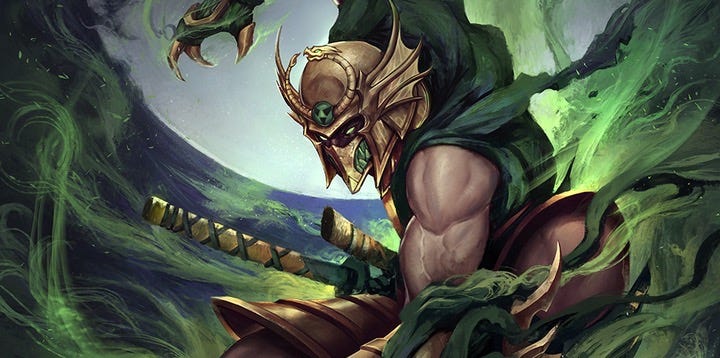 Togashi Yokuni by Le Vuong
Togashi Yokuni by Le Vuong
Summary
The Dragon have often been described as enigmatic. I think it is fair to say that many designers have struggled to work out exactly what the Dragon should do. It looks like FFG have worked it out. The Dragon are flexible like water.
“Empty your mind, be formless, shapeless — like water. Now you put water into a cup, it becomes the cup, you put water into a bottle, it becomes the bottle, you put it in a teapot, it becomes the teapot. Be water, my friend.” — Bruce Lee
A sample deck using Unicorn for influence is provided below.
Next up we have the Crab clan.

If you have any comments or feedback please post them in the comments section below.
This article was last updated on 15 September 2017.
Join us on our Twitch stream every second Monday at 8pm BST, 9pm CEST, 1pm PST.
Check us out on the Imperial Advisor website, podcast, and YouTube channel for more discussion about the L5R LCG.

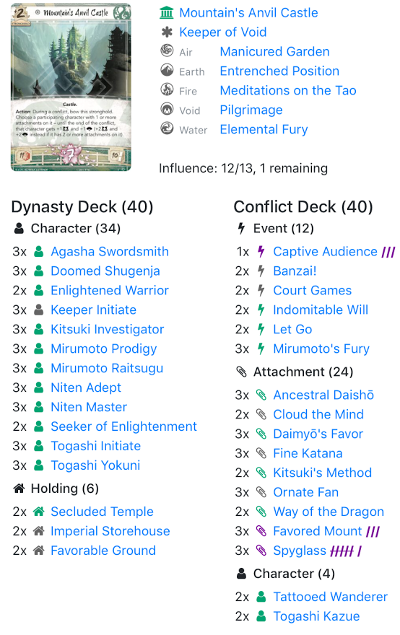
 Bazleebub
Bazleebub
One Reply to “Clan Focus – The Dragon”
Each article is better than the last- really getting to the heart of how each clan will approach the game- keep it up.